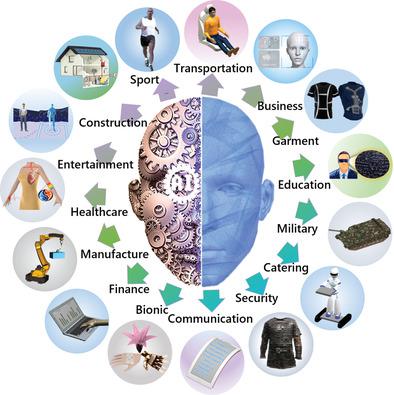当前位置:
X-MOL 学术
›
Adv. Mater.
›
论文详情
Our official English website, www.x-mol.net, welcomes your
feedback! (Note: you will need to create a separate account there.)
Fiber/Fabric-Based Piezoelectric and Triboelectric Nanogenerators for Flexible/Stretchable and Wearable Electronics and Artificial Intelligence.
Advanced Materials ( IF 27.4 ) Pub Date : 2019-07-26 , DOI: 10.1002/adma.201902549 Kai Dong 1 , Xiao Peng 1 , Zhong Lin Wang 1, 2
Advanced Materials ( IF 27.4 ) Pub Date : 2019-07-26 , DOI: 10.1002/adma.201902549 Kai Dong 1 , Xiao Peng 1 , Zhong Lin Wang 1, 2
Affiliation

|
Integration of advanced nanogenerator technology with conventional textile processes fosters the emergence of textile-based nanogenerators (NGs), which will inevitably promote the rapid development and widespread applications of next-generation wearable electronics and multifaceted artificial intelligence systems. NGs endow smart textiles with mechanical energy harvesting and multifunctional self-powered sensing capabilities, while textiles provide a versatile flexible design carrier and extensive wearable application platform for their development. However, due to the lack of an effective interactive platform and communication channel between researchers specializing in NGs and those good at textiles, it is rather difficult to achieve fiber/fabric-based NGs with both excellent electrical output properties and outstanding textile-related performances. To this end, a critical review is presented on the current state of the arts of wearable fiber/fabric-based piezoelectric nanogenerators and triboelectric nanogenerators with respect to basic classifications, material selections, fabrication techniques, structural designs, and working principles, as well as potential applications. Furthermore, the potential difficulties and tough challenges that can impede their large-scale commercial applications are summarized and discussed. It is hoped that this review will not only deepen the ties between smart textiles and wearable NGs, but also push forward further research and applications of future wearable fiber/fabric-based NGs.
中文翻译:

基于纤维/织物的压电和摩擦纳米发电机,用于柔性/可拉伸和可穿戴电子和人工智能。
先进的纳米发电机技术与传统的纺织工艺相结合,促进了基于纺织的纳米发电机(NGs)的出现,这将不可避免地促进下一代可穿戴电子设备和多方面人工智能系统的快速发展和广泛应用。NG为智能纺织品提供了机械能收集和多功能自供电感应功能,而纺织品则为其开发提供了灵活的多功能设计载体和广泛的可穿戴应用平台。但是,由于缺乏专业知识的研究人员与擅长纺织品的研究人员之间缺乏有效的互动平台和沟通渠道,要获得兼具出色的电输出性能和出色的纺织品相关性能的基于纤维/织物的NG,是相当困难的。为此,对可穿戴纤维/基于织物的压电纳米发电机和摩擦电动纳米发电机的当前技术水平进行了严格的评论,涉及基本分类,材料选择,制造技术,结构设计和工作原理,以及潜在的应用。此外,总结和讨论了可能阻碍其大规模商业应用的潜在困难和艰巨挑战。希望这次审查不仅将加深智能纺织品与可穿戴NG之间的联系,而且还将推动未来可穿戴纤维/织物NG的进一步研究和应用。对可穿戴纤维/基于织物的压电纳米发电机和摩擦电动纳米发电机的最新技术进行了严格的评述,涉及基本分类,材料选择,制造技术,结构设计和工作原理以及潜在的应用。此外,总结和讨论了可能阻碍其大规模商业应用的潜在困难和艰巨挑战。希望这次审查将不仅加深智能纺织品与可穿戴NG之间的联系,而且还将推动未来可穿戴纤维/织物NG的进一步研究和应用。对可穿戴纤维/基于织物的压电纳米发电机和摩擦电动纳米发电机的最新技术进行了严格的评述,涉及基本分类,材料选择,制造技术,结构设计和工作原理以及潜在的应用。此外,总结和讨论了可能阻碍其大规模商业应用的潜在困难和艰巨挑战。希望这次审查将不仅加深智能纺织品与可穿戴NG之间的联系,而且还将推动未来可穿戴纤维/织物NG的进一步研究和应用。材料选择,制造技术,结构设计和工作原理以及潜在的应用。此外,总结和讨论了可能阻碍其大规模商业应用的潜在困难和艰巨挑战。希望这次审查将不仅加深智能纺织品与可穿戴NG之间的联系,而且还将推动未来可穿戴纤维/织物NG的进一步研究和应用。材料选择,制造技术,结构设计和工作原理以及潜在的应用。此外,总结和讨论了可能阻碍其大规模商业应用的潜在困难和艰巨挑战。希望这次审查不仅将加深智能纺织品与可穿戴NG之间的联系,而且还将推动未来可穿戴纤维/织物NG的进一步研究和应用。
更新日期:2020-02-04
中文翻译:

基于纤维/织物的压电和摩擦纳米发电机,用于柔性/可拉伸和可穿戴电子和人工智能。
先进的纳米发电机技术与传统的纺织工艺相结合,促进了基于纺织的纳米发电机(NGs)的出现,这将不可避免地促进下一代可穿戴电子设备和多方面人工智能系统的快速发展和广泛应用。NG为智能纺织品提供了机械能收集和多功能自供电感应功能,而纺织品则为其开发提供了灵活的多功能设计载体和广泛的可穿戴应用平台。但是,由于缺乏专业知识的研究人员与擅长纺织品的研究人员之间缺乏有效的互动平台和沟通渠道,要获得兼具出色的电输出性能和出色的纺织品相关性能的基于纤维/织物的NG,是相当困难的。为此,对可穿戴纤维/基于织物的压电纳米发电机和摩擦电动纳米发电机的当前技术水平进行了严格的评论,涉及基本分类,材料选择,制造技术,结构设计和工作原理,以及潜在的应用。此外,总结和讨论了可能阻碍其大规模商业应用的潜在困难和艰巨挑战。希望这次审查不仅将加深智能纺织品与可穿戴NG之间的联系,而且还将推动未来可穿戴纤维/织物NG的进一步研究和应用。对可穿戴纤维/基于织物的压电纳米发电机和摩擦电动纳米发电机的最新技术进行了严格的评述,涉及基本分类,材料选择,制造技术,结构设计和工作原理以及潜在的应用。此外,总结和讨论了可能阻碍其大规模商业应用的潜在困难和艰巨挑战。希望这次审查将不仅加深智能纺织品与可穿戴NG之间的联系,而且还将推动未来可穿戴纤维/织物NG的进一步研究和应用。对可穿戴纤维/基于织物的压电纳米发电机和摩擦电动纳米发电机的最新技术进行了严格的评述,涉及基本分类,材料选择,制造技术,结构设计和工作原理以及潜在的应用。此外,总结和讨论了可能阻碍其大规模商业应用的潜在困难和艰巨挑战。希望这次审查将不仅加深智能纺织品与可穿戴NG之间的联系,而且还将推动未来可穿戴纤维/织物NG的进一步研究和应用。材料选择,制造技术,结构设计和工作原理以及潜在的应用。此外,总结和讨论了可能阻碍其大规模商业应用的潜在困难和艰巨挑战。希望这次审查将不仅加深智能纺织品与可穿戴NG之间的联系,而且还将推动未来可穿戴纤维/织物NG的进一步研究和应用。材料选择,制造技术,结构设计和工作原理以及潜在的应用。此外,总结和讨论了可能阻碍其大规模商业应用的潜在困难和艰巨挑战。希望这次审查不仅将加深智能纺织品与可穿戴NG之间的联系,而且还将推动未来可穿戴纤维/织物NG的进一步研究和应用。































 京公网安备 11010802027423号
京公网安备 11010802027423号